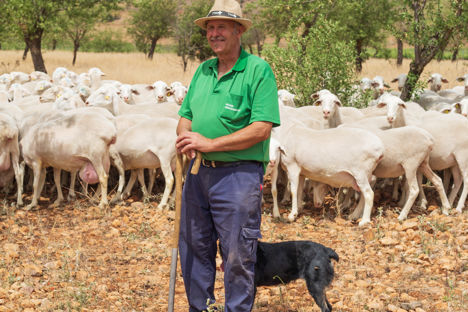
The food of Castile La Mancha
Home to Manchego cheese, fields of saffron and a host of unmissable traditional dishes, the region of Castile La Mancha is one of Spain’s unsung heroes. Rachel McCormack finds out what the region has to offer and how you can try its local dishes and delicacies here in the UK.
The food of Castile La Mancha
Home to Manchego cheese, fields of saffron and a host of unmissable traditional dishes, the region of Castile La Mancha is one of Spain’s unsung heroes. Rachel McCormack finds out what the region has to offer and how you can try its local dishes and delicacies here in the UK.
Castile La Mancha’s most famous son never actually existed. Miguel de Cervantes’ Don Quixote came from a ‘village in La Mancha, the name of which I do not care to remember’. Driven mad due to his brain ‘drying up’ from reading too many books of knightly chivalry, Don Quixote’s misadventures on Spain’s central plateau, known as la Meseta, were a product of Cervantes’ imagination turned into the first modern novel and published in 1605.
Nowadays Castile La Mancha’s vast plains, giant windmills and medieval towns and cities are often ignored by travellers in favour of either the capital city Madrid further inland or the coastal regions of Valencia and Murcia, reflecting the shifting population of Spain itself. Many parts of this inland region are so afflicted by emigration to the coast or the capital that their population has drastically fallen, a phenomenon now known as La España vacía, The Empty Spain, a term coined by journalist Sergio del Molina in his 2016 book of the same name. However despite this loss, the region is still home to many artisan food producers making the region’s famous Manchego cheese and growing its highly sought after saffron, supported internationally by companies like Brindisa who make their produce available in the UK to a wider audience.
Travelling in the region, visiting the capital Toledo with its old walled city and Jewish, Arab and Christian medieval monuments is to get a sense of the history of the whole of Spain, the people who have lived here and have made Spanish culture what it is. One of the area’s most famous dishes, sopa de ajo, a garlic soup, shows the ingenuity of Castile La Mancha’s peasants in creating something famous for being more than the sum of its parts. Originally, sopa de ajo was simply stale bread, garlic and hot water, reflecting the austere lives of both La Mancha’s peasants and its penniless aristocracy. In today’s far more abundant times, the dish is made with fresh chicken stock or water and eggs, often with added saffron, smoked sweet paprika and serrano ham and is a must have for any visitor to the region.
Away from the capital, smaller towns such as Cuenca, with its casas colgadas hanging houses built on the edges of ravine of the river Huécar, are famous for gazpachos manchegos. Unlike the cold tomato soup gazpacho of Andalusia, gazpachos manchegos is always known in the plural and is a game stew, made with partridge, rabbit or hare served on top of a special bread called torta cenceña. Other unmissable dishes of the region for the visitor are pisto manchego, a Castilian version of ratatouille using local seasonal vegetables – most frequently tomato and green pepper – mixed in with egg, and the famous milk-fed lamb from Albacete which is either roasted or made into a stew with other local ingredients.
One of the most famous products of Castile La Mancha is saffron. Brought by the Arab settlers in the ninth century, the dried stigmas of crocuses are more expensive than gold. This is due to the need for slow, careful manual labour when harvesting in the autumn and the fact each crocus only has two to three stigmas, so thousands of crocuses produce very little saffron. Rows of the famous purple flowers can be seen in fields in Castile La Mancha from the beginning of October and the whole saffron industry in the area is made up of small family-run businesses. The Castile La Mancha saffron available online at the Brindisa shop is Saffroman from Antonio Sotos S.L., a family business established in 1912 and now run by the fourth generation from the province of Albacete.
The other familiar Castile La Mancha product is the cheese Manchego, and Brindisa’s Manchego 1605, named after the date that Cervantes’ Don Quixote was first published, is one of the finest made. The tiny cheese maker works near the Cortijo Sierra La Solana in the province of Ciudad Real, surrounded by olive groves and almond trees, while the Cortijo itself offers rooms and self-catering options for rural tourism. Manchego 1605 is made using raw milk from sheep who have been grazing in the surrounding area. The whole process of making the cheese is done by hand under the close eye of the master cheese maker. The cheese is then matured for five or eleven months. Home of Spanish cheeses, another dairy highlight of the Brindisa shop is Zamorano, a beautiful artisan cheese very similar in style to Manchego but made in the province of Zamora in neighbouring Castile Leon.
While the wines of Castile La Mancha may not be as well known as other regions of Spain, they are an integral part of the huge leap in quality in Spanish wines in recent decades and Bodegas Ponce in the province of Cuenca is one of the examples of that leap. Owner and winemaker Juan Antonio Ponce spent time working for renowned winemaker Telmo Rodriguez before returning to his native Cuenca to start working exclusively with the local Bobal grape. Today, he produces small amounts of high quality biodynamic natural red wine under the local D.O. Manchuela, one of the eight D.O.’s of the region.
This unjustly forgotten region of Spain is home to key historical and food centres that made the country famous long before the days of modern tourism. Whether you have a bite of its cheese, make some of its dishes in your own home or even manage to pay a visit to the region, it’s a taste of authentic old Spain using modern techniques and with modern comforts that Don Quixote could never have dreamt.



